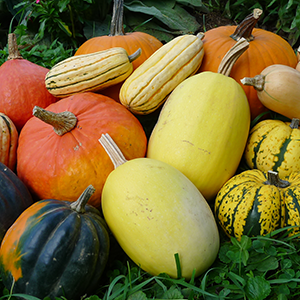
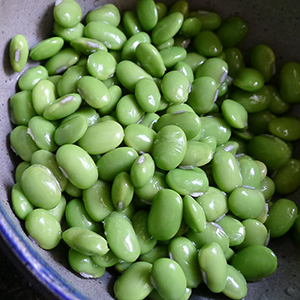
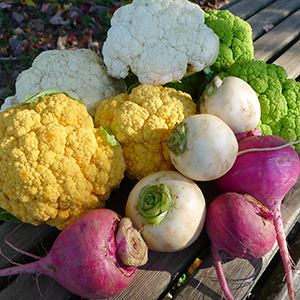
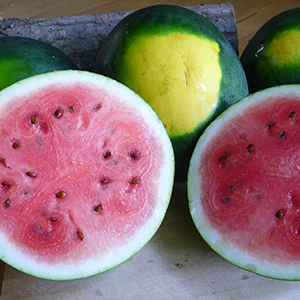
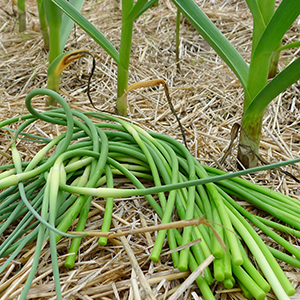
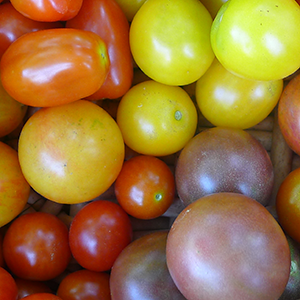



News and Notes | The Anchor Run Blog
Posts Filtered by Month - July 2022 |
Show Recent Posts
July 31, 2022
Summer Surge
by Farmer Derek
Summer Surge
by Farmer Derek

First watermelon haul of the season. They're on the smaller side this year due to reduced rainfall but still satisfy as only a watermelon can.
Harvest #11 (Week A) should include watermelon, beets, cucumbers, carrots, garlic, zucchini, green peppers, hot peppers, okra, shishito peppers, swiss chard, lettuce, herbs, eggplant, italian dandelion, tomatoes, onions, and scallions. Some items will be a choice. U-pick should include a handful of herbs, husk cherries, cherry tomatoes, tomatillos, blackberries, beans, and flowers. Soon green beans will transition to everyone's favorite, edamame! Also, tomatoes appear to be peaking so be prepared to carry a lot of weight. We had 1,500lbs harvested for this past Thursday's and Saturday's distribution. Will Monday's haul surpass that?

Leeks are looking great!

July 31, 2022
Rain Friends Respond
by Farmer Derek
Rain Friends Respond
by Farmer Derek

A welcome sight unseen for weeks.
Some much needed rain finally fell on the farm this past week (understatement). Since the 75% chance and up events have all missed us over the past month I figured we would receive some showers during a 30% chance event instead. The rain fell overnight so we weren't able to frolic and celebrate under the drops themselves but the soothing sounds made it through the open windows as a welcome midnight lullaby. This was an adequate drink for most of the crops and will give us brief relief from running irrigation daily. With how dry it's been, plus the incoming heat, we'll probably have to cycle irrigation through the fields again this coming week. But oh so thankful we are for the nice precipitation.
On Tuesday and Wednesday we transplanted a big round of late summer and early fall crops including kale, rutabaga, lettuce, cilantro, dill, celery, fennel, basil, beets, and chard. Even with the aid of the waterwheel transplanter these baby plants faced a challenging battle for moisture acquisition and retention with the parched soil. Next up for them and us is the task of weed management. One of the blessings of the extreme dry weather was less weed pressure due to fewer weed seeds actually germinating in the soil near the crops. Irrigation initiates some of the process but it seems to be more beneficial to our transplants, growing quickly and outcompeting their unwanted guests. We'll still need to get in there with our hands and hoes but we at least have a head start.
Last week we wrapped up the 2022 onion harvest with the help of CSA members. Approximately 3,000lbs of red and yellow onions are now being safely stored in our temperature and moisture controlled room. Considering the weed pressure we dealt with in late May and early June, this crop looks great. I think we've finally established our onion growing, harvesting, curing, and storage system and have two varieties that perform very well for us. I mostly love being able to bypass the standard curing process most farmers take where they pull all of the plants and lay them out somewhere under cover to dry out. For us, trimming off the tops, placing the onions in bins, and stacking in our low moisture cool room does the trick. It saves us a lot of time and hassle and seems to work just fine. I don't know about you, but I've been loving eating the red onions (and garlic!) raw as an addition to whatever else I'm eating. My body must need something they're providing, so I'm obliging. I don't think Dana minds.

July 31, 2022
Workshifts for Week of 8/1/22
by Farmer Derek
Workshifts for Week of 8/1/22
by Farmer Derek

Eastern tiger swallowtail butterfly snacking on some anise hyssop nectar.
If we get some good workshift attendance this week our plan is to begin harvesting potatoes. The potato digger will sift the potatoes out of the soil. We'll collect them and place them in bins.
These are family friendly shifts but please don't sign your kids up online (we need to make sure we have enough adults). If your kids work they will receive credit.
This week's workshift schedule:
- Tuesday 8/2 9-11am (should be potatoes)
- Wednesday 8/3 9-11am (should be potatoes)
- Wednesday 8/3 6-8pm (should be potatoes)
- Friday 8/5 9-11am (should be potatoes)
- Sunday 8/7 7-9am (early bird special!)
Bring gloves, water, a hat, sturdy shoes, and a pad for kneeling (if necessary for you)!
We meet under the large red maple at the end of the barn by the pick up room.
If you signed up for a CSA share with work discount but are unable to work please consider remitting payment in lieu of work sooner rather that later.

July 31, 2022
Summer Share Tips
by Farmer Dana
Summer Share Tips
by Farmer Dana
I'm sure most of you have missed (we have too!) the awesome and applicable recipe suggestions from long-time CSA member Linda Dansbury, who is taking a break this year, and we have done a poor job keeping up with that most important section of the newsletter. But here are a few tips on how to use/preserve/enjoy this week's harvest contents:
Tomatoes
Fresh salsa - puree, or simply chop, tomatoes, onion, hot pepper, garlic, and cilantro. Toss together with salt and pepper to taste. Perfect hot weather snack.
We like to slice them and enjoy with simple cheese omelettes for easy weeknight dinners. Season with salt and pepper, garnish with parsley.
If you're unable to get to them fast enough you can always freeze them whole to use later in the year/over the winter. You could core them first, but I don't process them in any way. They're perfect to use in sauces or any cooked tomato dishes, and the skins come off super easily (if you're into that).
Zucchini
If you're using the grill, just slice length-wise and throw a few on the grate. Even if you're not eating them that night you can chop and incorporate into mixed salads throughout the week.
This is a good recipe (zucchini butter spaghetti) from Smitten Kitchen (which is a good resource for other seasonal cooking ideas) that uses a pound and a half of zucchini.
Make a batch or two of zucchini bread to eat fresh and freeze for later.

July 24, 2022
Well Water Sweetened
by Farmer Derek
Well Water Sweetened
by Farmer Derek

Staked and supported peppers with living mulch aisles that need to be mowed periodically.
Harvest #10 (Week B) should include beets, carrots, garlic, fennel, zucchini, green peppers, swiss chard, lettuce, herbs, eggplant, italian dandelion, tomatoes, onions, and scallions. Some items will be a choice. U-pick should include a handful of herbs, green/string/snap beans, cherry tomatoes, tomatillos, blackberries, and flowers.

Feeding next year's edible crops with compost applied now before late-summer sown cover crops.

July 24, 2022
Workshifts for Week of 7/25/22
by Farmer Derek
Workshifts for Week of 7/25/22
by Farmer Derek

Anchor Run Farm 'corn crib', considered one of the oldest and/or most historically accurate/preserved buildings on the farm.
This week's workshift schedule
- Tuesday 7/26 9-11am
- Wednesday 7/27 9-11am
- Wednesday 7/27 6-8pm
- Friday 7/29 9-11am
- Sunday 7/31 7-9am (early bird special!)
Bring gloves, water, a hat, sturdy shoes, and a pad for kneeling (if necessary for you)!
We meet under the large red maple at the end of the barn by the pick up room.

July 24, 2022
Yes We Can, Irrigate
by Farmer Derek
Yes We Can, Irrigate
by Farmer Derek

Approximately 7,000 feet of reused drip tape was applied on the newly transplanted broccoli, cabbage, and cauliflower.
What time is it? Irrigation time! We've now added water to all of the crops we're physically able to. Those less fortunate include the u-pick flowers, sweet potatoes, herb garden, and regular potatoes. Adding water to the fields is a serious investment in resources. Sometimes we don't have enough material or enough time to set up the necessary infrastructure and sacrifices have to be made. It comes down to which plants tend to tolerate water stress better and where they're at in terms of maturity. For example, everything in the herb garden appears to be doing just fine, possibly due to the addition of infinite amounts of wood chips over the years (thanks Gareth!). Many of the potato varieties are nearing harvest readiness and aren't bulking up anymore. Sweet potatoes seem to do well no matter what as long as they're able to outcompete the weeds when they're young. The flower patch is probably thirsty and could probably use a drink, but that's hard to justify right now. If the next round of rain misses us we may consider setting up some overhead sprinklers out there.
I think by now we've fully adjusted, mentally and physically, to this new weather pattern. I'm not afraid anymore. Dry, windy, 100 degrees, no problem. Accept and adapt. Surely we'll see more of these types of events in the years to come and knowing how to prepare and survive is key. We're fortunate that we have a nice deep well that supplies enough water. We're fortunate that we have the ability and time to give all these food crops a drink when they need it. Things could change but for now we utilize what we can to ensure an ample harvest. Stressful? Sure. Satisfying? Maybe later. Tired? Nope, energized because August is almost here, then September and the glory of fall.

Sometimes I remember to wear a mask when it's this dry and dusty. I always remember the noise-canceling headphones for auditory entertainment.

July 24, 2022
Herb of the Week: Nasturtium
By Gia Yaccarino
Herb of the Week: Nasturtium
By Gia Yaccarino
Nasturtium (Tropaeolum)
The flowers and leaves are edible. Try throwing some into your next salad. The flowers have a bit of a peppery taste.
I made a “pesto” with the leaves – I pureed the following together: Nasturtium leaves, Kalamatta Olive juice, garlic scapes, Romano cheese.
Benefits
- Excellent source of Vitamin C
- Antibacterial
- Antifungal
- Antiseptic
- Wound healing
Some wonderful ways to use Nastrurtium can be found here: https://askthefoodgeek.com/nasturtium/
Safe for cats: Yes
Safe for dogs: While not palatable to most dogs due to the peppery taste, it can cause GI upset if ingested

July 17, 2022
U-pick Uptick
by Farmer Dana
U-pick Uptick
by Farmer Dana
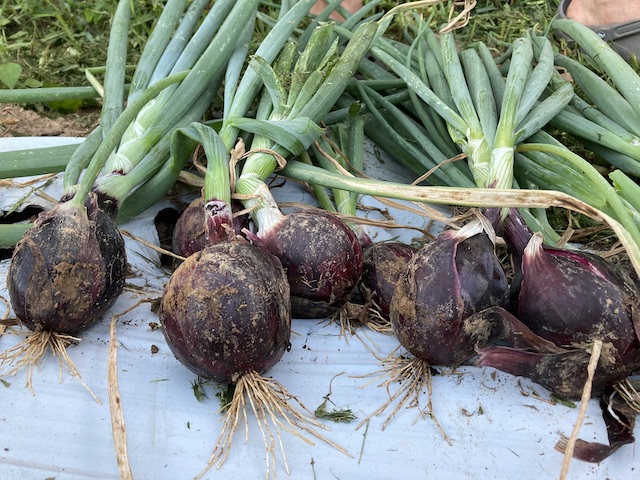
Red onions!
Harvest #9 (Week A) should include beets, carrots, garlic, fennel, zucchini, green peppers, swiss chard, lettuce, herbs, eggplant, italian dandelion, tomatoes, fresh onions, and scallions. Some items will be a choice. U-pick should include a handful of herbs, green/string/snap beans, cherry tomatoes, tomatillos, and flowers.
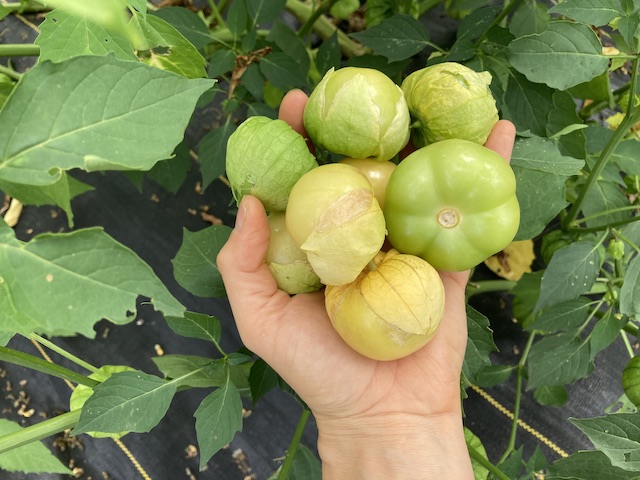
Ripe tomatillos fill out and split open their enveloping husk.

July 17, 2022
Workshifts for Week of 7/18/22
by Farmer Derek
Workshifts for Week of 7/18/22
by Farmer Derek
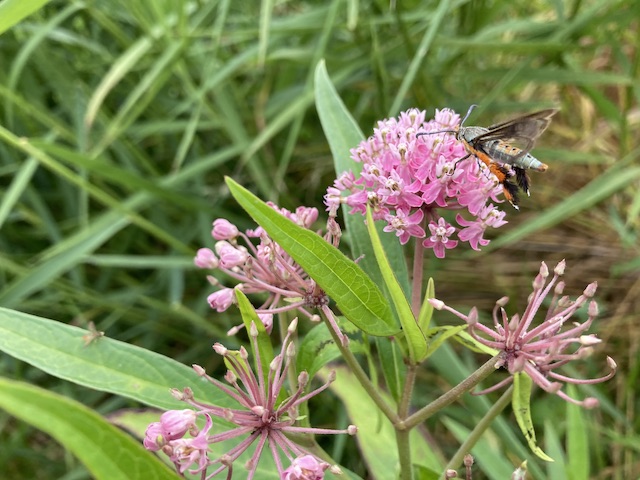
A beautiful insect on a beautiful plant, swamp milkweed. Let us know if you can ID the critter.
This week's workshift schedule
- Tuesday 7/19 8-10am
- Wednesday 7/20 8-10am
- Friday 7/22 8-10am
- Sunday 7/24 7-9am (early bird special!)
Bring gloves, water, a hat, sturdy shoes, and a pad for kneeling (if necessary for you)!
We meet under the large red maple at the end of the barn by the pick up room.

July 17, 2022
Herb of the Week: Calendula
By Gia Yaccarino
Herb of the Week: Calendula
By Gia Yaccarino
While doing yardwork last weekend, I came in contact with some poison ivy and by Tuesday a rash was developing on my forearms.
What a perfect reason to try this week’s herb, Calendula, as a topical remedy!
I placed the flowers in a pint mason jar (about halfway loosely filled with fresh flowers), poured simmering water over the flowers, and covered.
Once it cooled, I dipped a cloth in the tea and applied as a compress. (Confession: While I was waiting for it to infuse and cool, I picked one of the flowerheads out of the water and rubbed that on my poison ivy rash. It was immediately soothing!)
Another idea is making ice cubes with the tea and rubbing the ice cube on the rash (I have yet to try that!).
Calendula (Calendula officinalis, Asteraceae)
Benefits
- Anti-inflammatory
- Stimulating the lymphatic system
- Topically for rashes
- Vulnerary (promotes wound healing)
- Antibacterial
- Antifungal
Uses
- Petals can be used in salads, egg dishes, salsa
- Flower heads can be frozen in ice cubes
- Calendula tea can be used
- topically for rashes/skin irritations
- gargle for a sore throat
- mouth rinse for inflamed gums
Safe for cats: Yes
Safe for dogs: Yes
Cautions
- Use with caution if pregnant
- This part of the aster family so for those who are reactive to ragweed (Ambrosia spp.) and chamomile (Matricaria recutita), use with caution

July 17, 2022
Farming It Is
by Farmer Derek
Farming It Is
by Farmer Derek
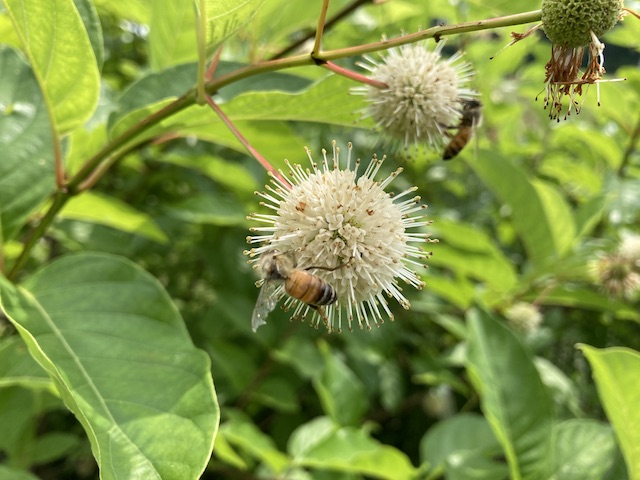
Honeybees on buttonbush blossoms.
Fifteen years farming full-time and I still forget how challenging (and/or frustrating) it is to grow produce during a dry spell in the heat of summer. But then, just like that, some unexpected rain falls overnight, barely audible over the drone of the box fan in the window, puddles on the driveway are woken up to, and the magical gift of rain is given and a brief feeling of contentment returns. Three-tenths of an inch last night should be enough to staunch the outgoing life-force-flow from the 6,100 broccoli, cabbage, and cauliflower plants that went in 3,500' of beds last Tuesday, preceding the disappearing act of dissipated forecasted rain that night. The subsequent four bright sunshine 90 degree days fully tested their resolve and our skill at transplanting successfully while making it apparent that transplanting with the water-wheel transplanter is essential. Stress test indeed.
Rejoice! Sixty percent of the onions were harvested on Friday by a CSA workshift and the farm crew, all of them red and of intermediate day length sensitivity, meaning they began bulbing when day length reached 14 hours or so, sometime in early/mid June. They are some of the nicest onions we've grown and we're excited to share them with you. We bypass some of the fancy curing process for onions and instead simply trim the tops about an inch above the bulb when some of the tops begin falling over and the onions begin to have the papery skin on the outside. They go right into our dry and cool storage room where they will continue to dry and cure somewhat. These aren't meant for longterm storage. The other 40% of onions are a long-day variety, meaning they don't begin to bulb until day length reaches 14-16 hours, and thus mature later. I think we've narrowed down our onions to two good and reliable varieties. Growing only two varieties instead of five makes staying on top of harvesting at the right time a bit easier. Enjoy!
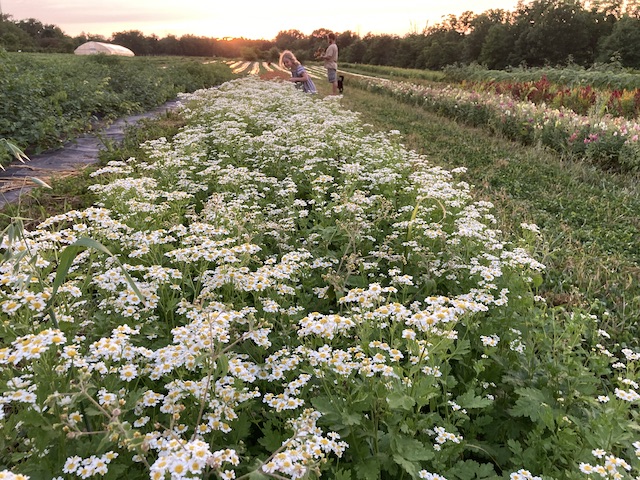
Collecting flowers while the sun sets.

July 10, 2022
Tastes Like Summer
by Farmer Derek
Tastes Like Summer
by Farmer Derek
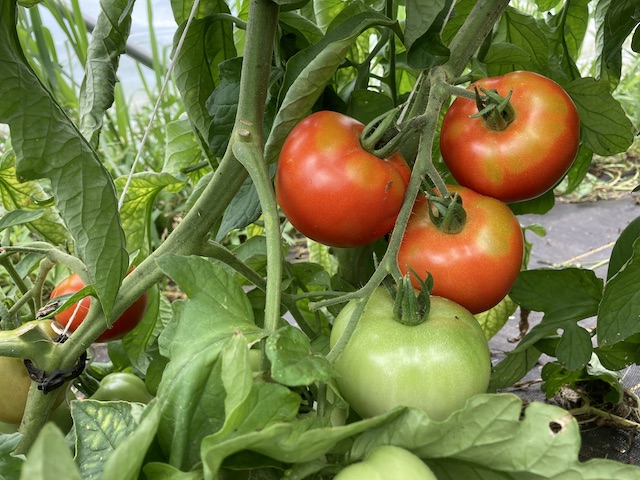
Our early tomato variety, New Girl, is starting to ripen!
Harvest #8 (Week B) should include garlic, fennel, cucumbers, zucchini, kohlrabi, cabbage, celery, swiss chard, lettuce, herbs, eggplant, italian dandelion, tomatoes, and scallions. Some items will be a choice. Tomatoes are just starting to ripen. Cucumber weight may dip slightly until our 3rd planting is ready. Zucchini should be plentiful and eggplant are looking good. U-pick should include a handful of herbs, green/string/snap beans, cherry tomatoes, and flowers.
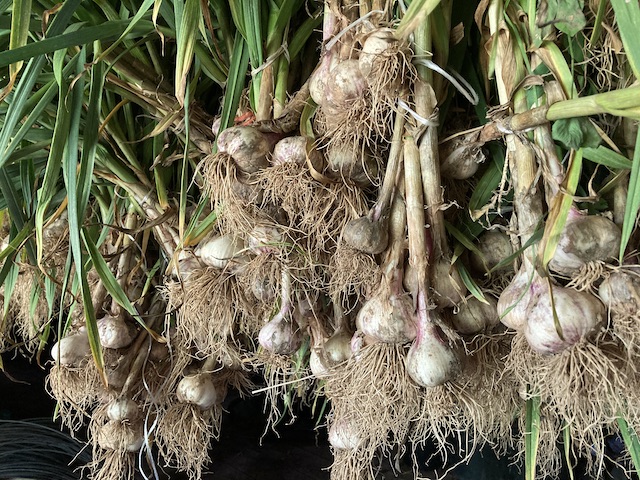
Bundled garlic hanging to cure.

July 10, 2022
Workshifts for Week of 7/11/22
by Farmer Derek
Workshifts for Week of 7/11/22
by Farmer Derek
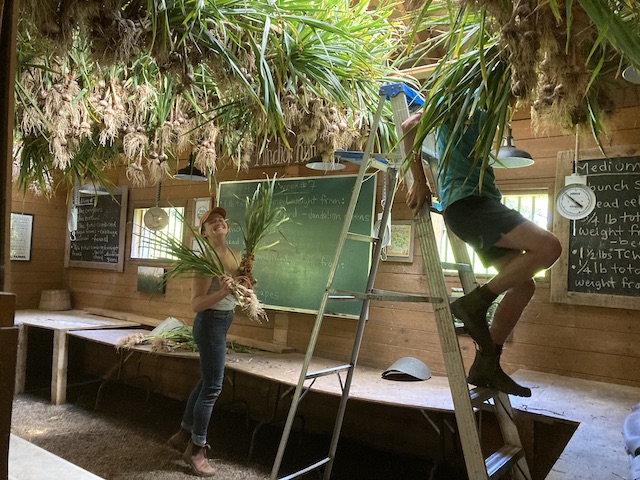
Farmer Sarah and partner Connor hanging garlic in the pick up room.
This week's workshift schedule
- Wednesday 7/13 9-11am (harvesting carrots)
- Wednesday 7/13 6-8pm (harvesting carrots)
- Friday 7/15 9-11am (harvesting carrots)
- Sunday 7/17 7-9am (early bird special!)
Bring gloves, water, a hat, sturdy shoes, and a pad for kneeling (if necessary for you)!
We meet under the large red maple at the end of the barn by the pick up room.

July 10, 2022
Herb of the Week: Lemon Balm
By Gia Yaccarino
Herb of the Week: Lemon Balm
By Gia Yaccarino
I have given myself the challenge of incorporating more herbs into my life. I feel like I know how to use the 3 farm standards: basil, dill and cilantro. So I am going to try to include some of the “non-standard” herbs.
My first trial was with Lemon Balm. I have been having problems sleeping for the past week, so I tried some Lemon Balm tea in the evening. I used about ¼ cup (leaves, stems, flowers) Lemon Balm chopped in a tea strainer and let it steep, covered for at least 10 minutes.
Lemon Balm (Melissa officinalis) Benefits:
- Reduce stress, anxiety
- Helps with sleep
- Antiviral properties (topical application for cold sores)
- Mosquitoes and gnats repellant
Uses:
- Teas
- Added to salads
- Cooked with fish
- Infused vinegar
- Pesto
Safe for cats: Yes
Safe for dogs: Yes
Caution: Individuals on thyroid medications or sedatives should consult their physician

July 10, 2022
Garlic (is) History
by Farmer Derek
Garlic (is) History
by Farmer Derek
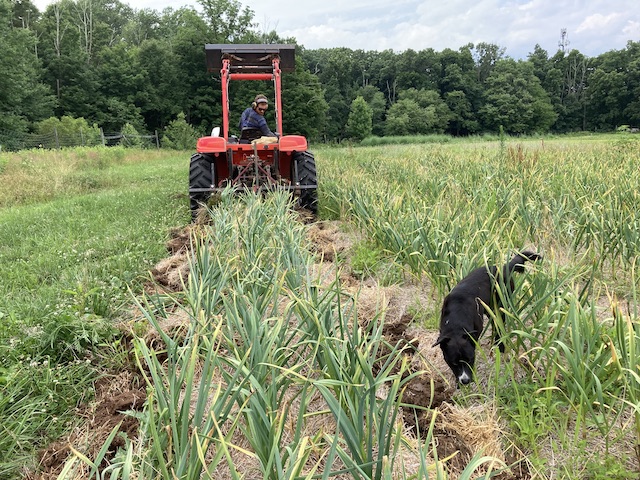
The first step to harvesting garlic is undercutting the beds which fractures and loosens the soil for an easier pull up of the plant.
Around 15,000 garlic bulbs have been harvested, retrieved, bundled, hung, and pruned with the help of 60 farmers and CSA members. We started pulling at 8am Sunday morning and just after noon the final bundles were hung in the barn. This is a monumental undertaking and we're so thankful we can accomplish the task with help from our food community. The garlic looks good, too.
This crop was planted last November from cloves saved from last year's harvest. Garlic cloves have been saved and planted from each harvest over the past 18 farming seasons at Anchor Run. Garlic bulbs/cloves/seed were last purchased in 2003 or 4 and I've heard that it's now safe to say we have unique varieties to our farm (I'm not 100% certain this is true, however, since we're planting parental clones in the form of cloves but apparently there are studies that found that changes can occur when environmental conditions change among other things).
Bundled garlic will hang and cure in the barn for a couple of months. Garlic that was pruned today will be distributed immediately as 'fresh and uncured'. Skin is removed more easily and the taste is more mild. These bulbs can be stored on your counter. This year we're not going to refrigerate the fresh garlic which can cause it to deteriorate more quickly in storage. Enjoy!

A few of the many helpers today that may have a certain smell about them for a while.

July 3, 2022
Workshifts for Week of 7/4/22
by Farmer Derek
Workshifts for Week of 7/4/22
by Farmer Derek
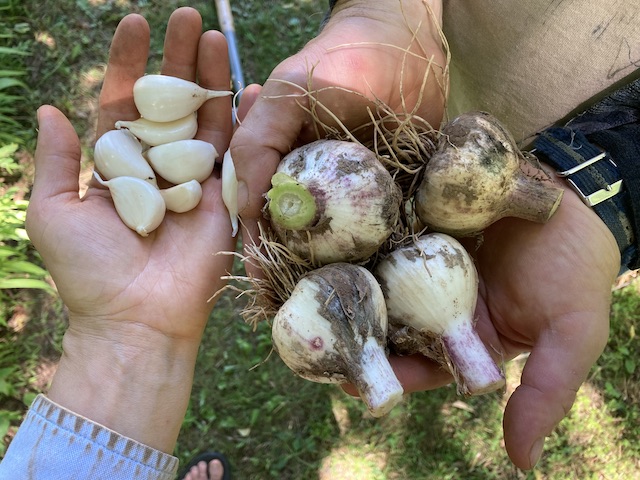
Garlic maturity check. The Great Garlic Harvest will be scheduled for either Sunday July 10 or Sunday July 17.
This week's workshift schedule:
- Tuesday 7/5 9-11am
- Wednesday 7/6 9-11am
- Wednesday 7/6 6-8pm
- Friday 7/8 9-11am
- Sunday 7/10 8-10am (this may become The Great Garlic Harvest; will monitor forecast and decide midweek)
Bring gloves, water, a hat, sturdy shoes, and a pad for kneeling (if necessary for you)!
We meet under the large red maple at the end of the barn by the pick up room.
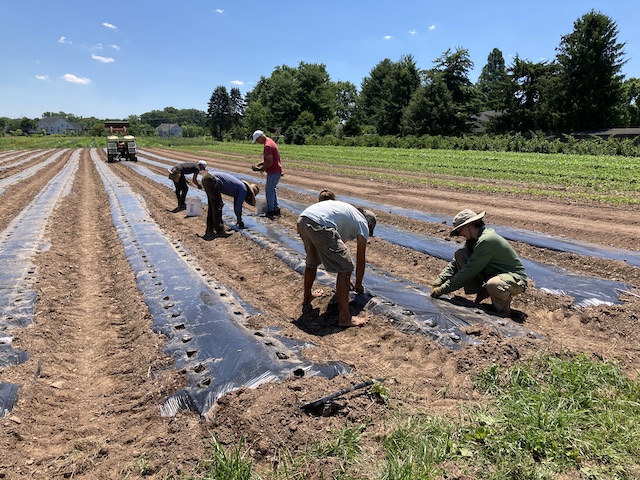
Planting 7,000 strawberry bare root tips for a 2023 harvest. Now we just need some rain please.

July 3, 2022
Early July Produce
by Farmer Dana
Early July Produce
by Farmer Dana
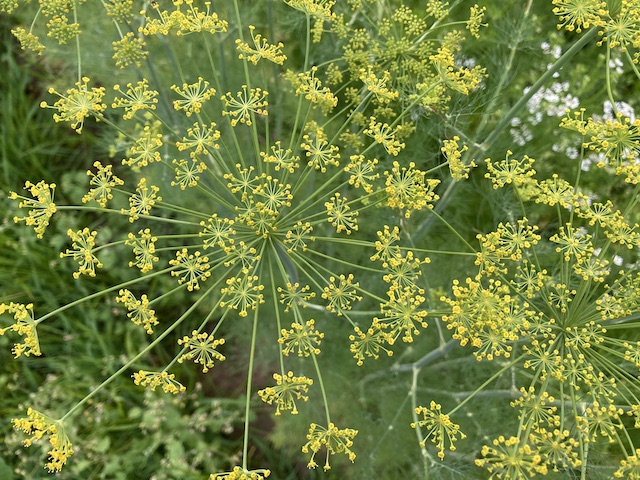
Dill blossom fireworks!
Harvest #7 (Week A) should include cucumbers, zucchini, kohlrabi, cabbage, celery, kale, swiss chard, lettuce, herbs, scallions, and garlic scapes. Some items will be a choice. Maybe some surprises. U-pick should include a handful of herbs, green/string/snap beans, and flowers.

July 3, 2022
The Pond is Dry
by Farmer Derek
The Pond is Dry
by Farmer Derek
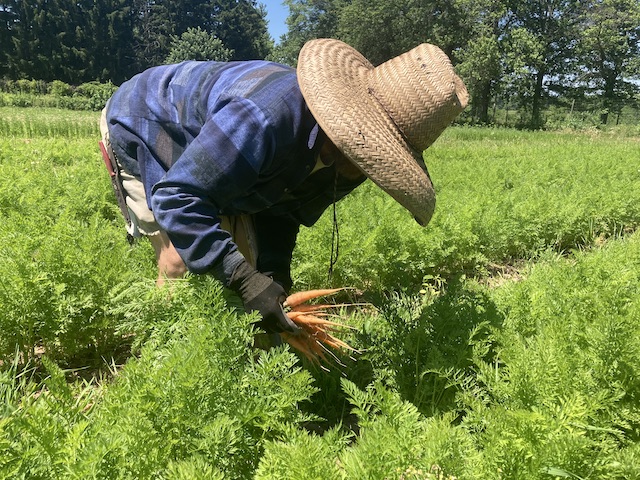
Spring/summer carrot check - not quite ready but looking totally good!
Serious consideration of adding underground water to the crops is underway. After two rounds of rain missed us on Friday and Saturday evenings the pond is now dry and the farmers are a bit worried. This is a regular annual circumstance, though the exact timing shifts by weeks or months forward or backward. We accept our fate of connecting drip tubes, running out 1.5" header lines, erecting sprinklers, etc, on a Sunday when our bodies would rather rest.
The crops we'll irrigate first are the ones grown in covered beds that already have drip tubes buried near crops' root zone. These include cherry tomatoes, peppers, eggplant, zucchini, new strawberries, winter squash, and cucumbers. We'll work incrementally, starting with the most vulnerable plants first, because we can only irrigate so much bed feet at a given time. We'll try to hook up and add water to all summer crops that meet these criteria before the day is out. To provide crops with a serious drink requires a minimum of four hours so if we're lucky maybe we'll get three groups watered today.
Bare ground crops, like lettuce, beets, chard, celery, beans, flowers, potatoes, etc, will most likely have to wait for the next round of rainfall due to limited time and infrastructure constraints but mostly because they'll be fine. Our relatively heavy, clay based soils predominately face north and have high organic matter resulting in good water retention and less evaporation. It takes a while to harm bare ground crops and in 14 years I've not seen them suffer from lack of moisture. Their growth may slow a bit but they're content being idle for a minute.
Like I said, dealing with dry times is normal. We monitor the weather forecast frequently and strive to only irrigate as a last resort (rain is more beneficial to crops than groundwater). After three months of regular and sometimes excessive rainfall, adding water feels a bit unnecessary and a waste of valuable time. Unfortunately all that extra water percolated below root zones or flowed out to sea. Typically what happens is we'll spend a week or so installing and running irrigation then we'll re-enter a wet period and won't use it again. But you never know so we still have to go through the motions to keep our plants happy and productive. And that should help us sleep better at night.

An ancient oak, perhaps 200 years old, split in half on Sunday and crushed 40' of deer fence. We've been waiting for this to happen for years as the crack has grown. Fortunately no one was nearby when it occurred.

POSTS BY TYPE
POSTS BY MONTH

